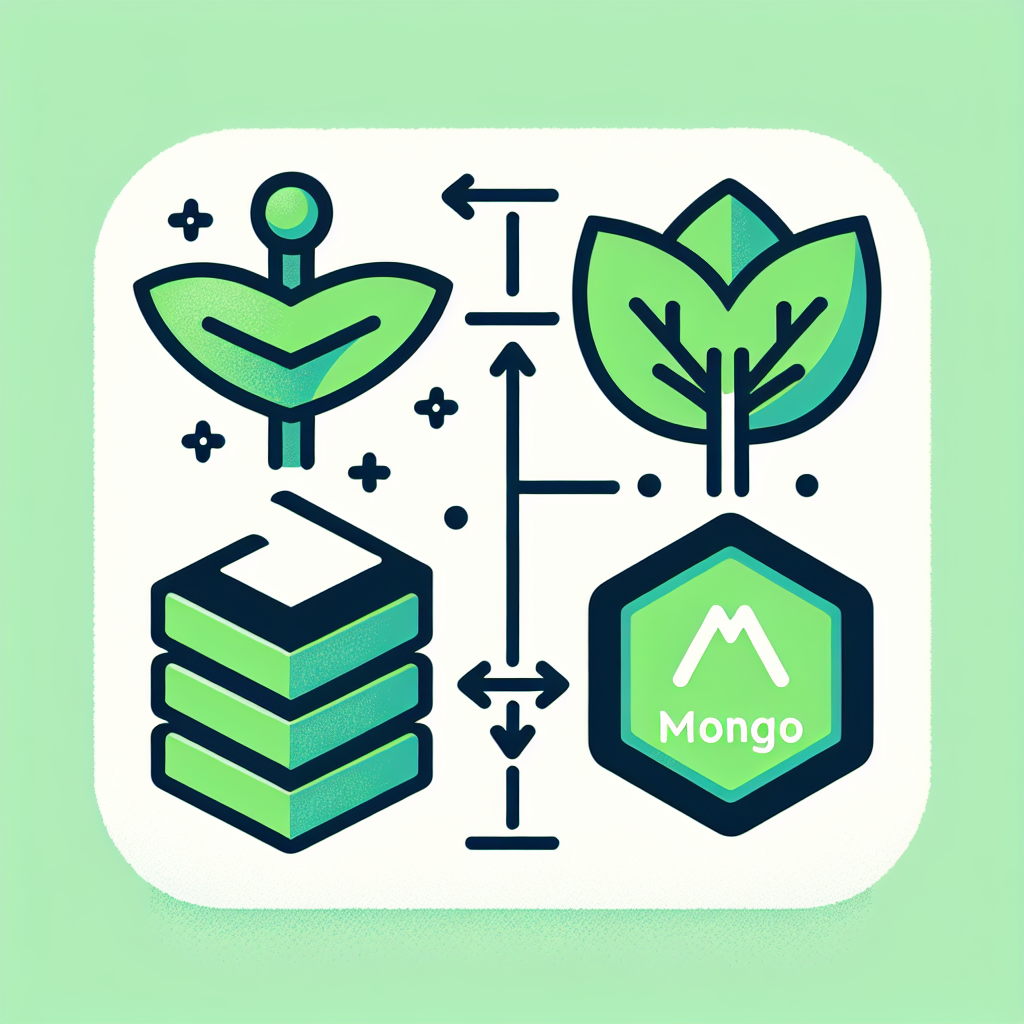Exploring the Benefits of Using Express with MongoDB
Express and MongoDB are two powerful tools that can be used together to create robust and scalable web applications. In this article, we will explore the benefits of using Express with MongoDB and how they complement each other to enhance the development process.
Express is a fast and minimalist web application framework for Node.js. It provides a simple and intuitive way to build web applications and APIs. With its lightweight design, Express allows developers to create applications quickly and efficiently. It also offers a wide range of features and middleware that can be easily integrated into the application.
On the other hand, MongoDB is a popular NoSQL database that is known for its flexibility and scalability. It stores data in a JSON-like format, making it easy to work with and manipulate. MongoDB also offers powerful querying capabilities and automatic sharding, which allows for horizontal scaling of data.
When used together, Express and MongoDB offer several benefits that can greatly enhance the development process. One of the main advantages is the ease of integration. Express provides a built-in middleware called “express-mongo-db” that allows developers to connect to a MongoDB database with just a few lines of code. This makes it incredibly easy to start working with MongoDB in an Express application.
Another benefit of using Express with MongoDB is the flexibility it offers. Since both Express and MongoDB are highly customizable, developers have the freedom to design their applications according to their specific needs. Express allows for easy routing and handling of HTTP requests, while MongoDB provides a flexible schema-less data model. This combination allows developers to quickly iterate and adapt their applications as requirements change.
Scalability is another area where Express and MongoDB shine. Express is designed to handle a large number of concurrent requests, making it ideal for building scalable web applications. MongoDB, on the other hand, offers automatic sharding, which allows for horizontal scaling of data across multiple servers. This means that as the application grows, it can easily handle increased traffic and data storage requirements.
Security is also a crucial aspect of any web application. Express provides several security features, such as built-in support for HTTPS and CSRF protection. MongoDB, on the other hand, offers robust authentication and authorization mechanisms to ensure that only authorized users can access the data. By using Express with MongoDB, developers can build secure applications that protect sensitive user information.
In conclusion, using Express with MongoDB offers several benefits that can greatly enhance the development process. The ease of integration, flexibility, scalability, and security provided by these tools make them a powerful combination for building robust and scalable web applications. Whether you are a beginner or an experienced developer, using Express with MongoDB can help you create applications that are efficient, flexible, and secure. So, if you are looking to build a web application, consider using Express with MongoDB and experience the benefits for yourself.
Best Practices for Integrating Express and MongoDB in Your Web Application

Express and MongoDB are two powerful tools that can greatly enhance the functionality and performance of your web application. When used together, they can provide a seamless and efficient experience for both developers and users. In this article, we will discuss some best practices for integrating Express and MongoDB in your web application.
One of the first things to consider when integrating Express and MongoDB is the structure of your data. MongoDB is a NoSQL database, which means it does not require a predefined schema. This flexibility can be both a blessing and a curse. On one hand, it allows you to easily adapt your data model as your application evolves. On the other hand, it can lead to a lack of consistency and make it difficult to maintain your codebase.
To address this issue, it is recommended to define a clear data schema for your MongoDB collections. This can be done using a library like Mongoose, which provides a simple and intuitive way to define schemas and models. By defining a schema, you can ensure that your data remains consistent and easily manageable.
Another best practice is to use middleware to handle database operations in Express. Middleware functions are functions that have access to the request and response objects, as well as the next middleware function in the application’s request-response cycle. This makes them ideal for performing tasks such as connecting to the database, handling errors, and sanitizing input.
By using middleware, you can keep your route handlers clean and focused on handling the business logic of your application. This separation of concerns makes your code more modular and easier to maintain. Additionally, middleware can be reused across different routes, further reducing code duplication.
When working with MongoDB, it is important to consider performance optimizations. One common optimization technique is indexing. Indexes allow MongoDB to quickly locate and retrieve data based on specified criteria. By creating indexes on frequently queried fields, you can significantly improve the performance of your queries.
Another performance optimization technique is to use aggregation pipelines. Aggregation pipelines allow you to perform complex data transformations and calculations on the server side, reducing the amount of data that needs to be transferred over the network. This can greatly improve the performance of your application, especially when dealing with large datasets.
In addition to performance optimizations, it is also important to ensure the security of your MongoDB database. MongoDB provides several security features, such as authentication and access control, that can help protect your data from unauthorized access. It is recommended to enable these features and follow best practices for securing your database, such as using strong passwords and regularly updating your software.
Finally, it is important to handle errors and exceptions gracefully when integrating Express and MongoDB. MongoDB can throw various types of errors, such as connection errors and query errors. By using try-catch blocks and error handling middleware, you can catch and handle these errors in a consistent and user-friendly manner.
In conclusion, integrating Express and MongoDB in your web application can greatly enhance its functionality and performance. By following best practices such as defining a clear data schema, using middleware, optimizing performance, ensuring security, and handling errors gracefully, you can create a robust and efficient application that provides a seamless experience for both developers and users.
Building a RESTful API with Express and MongoDB: A Step-by-Step Guide
Express and MongoDB are two powerful tools that can be used together to build a RESTful API. In this step-by-step guide, we will walk you through the process of building a RESTful API using Express and MongoDB.
First, let’s start by understanding what Express and MongoDB are. Express is a fast and minimalist web application framework for Node.js. It provides a robust set of features for web and mobile applications, making it a popular choice among developers. MongoDB, on the other hand, is a NoSQL database that provides high performance, scalability, and flexibility. It is designed to store and retrieve large amounts of data quickly and efficiently.
To get started, you will need to have Node.js and MongoDB installed on your machine. Once you have them installed, you can create a new directory for your project and navigate to it using the command line. From there, you can initialize a new Node.js project by running the command “npm init”. This will create a package.json file that will keep track of your project’s dependencies.
Next, you will need to install Express and MongoDB. You can do this by running the following commands in your project directory:
“`
npm install express
npm install mongodb
“`
Once you have installed the necessary dependencies, you can start building your RESTful API. The first step is to create an Express application. You can do this by creating a new file called “app.js” and adding the following code:
“`javascript
const express = require(‘express’);
const app = express();
app.listen(3000, () => {
console.log(‘Server is running on port 3000’);
});
“`
This code sets up a basic Express application and starts a server on port 3000. You can change the port number if you prefer.
Next, you will need to connect to your MongoDB database. You can do this by adding the following code to your “app.js” file:
“`javascript
const MongoClient = require(‘mongodb’).MongoClient;
const url = ‘mongodb://localhost:27017’;
MongoClient.connect(url, (err, client) => {
if (err) throw err;
const db = client.db(‘mydatabase’);
console.log(‘Connected to MongoDB’);
// Your API routes will go here
});
“`
This code connects to your local MongoDB database and logs a message to the console if the connection is successful. You will need to replace ‘mydatabase’ with the name of your own database.
Now that you have set up your Express application and connected to your MongoDB database, you can start defining your API routes. These routes will handle incoming requests and perform the necessary operations on your database.
For example, let’s say you want to create a route that retrieves all the documents from a collection called “users”. You can do this by adding the following code to your “app.js” file:
“`javascript
app.get(‘/users’, (req, res) => {
const collection = db.collection(‘users’);
collection.find({}).toArray((err, docs) => {
if (err) throw err;
res.json(docs);
});
});
“`
This code creates a GET route for “/users” that retrieves all the documents from the “users” collection and sends them back as a JSON response.
You can continue adding more routes to handle other CRUD operations such as creating, updating, and deleting documents. Express provides a convenient and intuitive way to define these routes, making it easy to build a fully functional RESTful API.
In conclusion, building a RESTful API with Express and MongoDB is a straightforward process. By following this step-by-step guide, you can create a powerful API that can handle a wide range of operations on your MongoDB database. Express and MongoDB work seamlessly together, providing a robust and efficient solution for building web and mobile applications. So go ahead and start building your own RESTful API with Express and MongoDB today!

